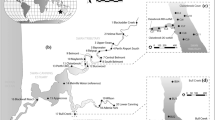Abstract
In response to a mandate in Section 118(c)(3) of the Water Quality Act of 1987, a program called Assessment and Remediation of Contaminated Sediments (ARCS) was established. Four technical work groups were formed. This paper details the research strategy of the Toxicity-Chemistry Work Group.
The Work Group's general objectives are to develop survey methods and to map the degree of contamination and toxicity in bottom sediments at three study areas, which will serve as guidance for future surveys at other locations. A related objective is to use the data base that will be generated to calculate sediment quality concentrations by several methods. The information needed to achieve these goals will be collected in a series of field surveys at three areas: Saginaw Bay (MI), Grand Calumet River (IN), and Buffalo River (NY). Assessments of the extent of contamination and potential adverse effects of contaminants in sediment at each of these locations will be conducted by collecting samples for physical characterization, toxicity testing, mutagenicity testing, chemical analyses, and fish bioaccumulation assays. Fish populations will be assessed for tumors and external abnormalities, and benthic community structure will be analyzed. A mapping approach will use low-cost indicator parameters at a large number of stations, and will extrapolate by correlation from traditional chemical and biological studies at a smaller number of locations. Sediment toxicity testing includes elutriate, pore water and whole sediment bioassays in a three-tiered framework. In addition to the regular series of toxicity tests at primary mater stations, some stations are selected for a more extensive suite of tests.
Similar content being viewed by others
References
Burton G. A.Jr., B. L.Stemmer, K. L.Winks, P. E.Ross & L. C.Burnett, 1989. A multitrophic level evaluation of sediment toxicity in Waukegan and Indiana Harbors. Environ. Toxicol. Chem. 8: 1057–1066.
Giesy J. P. & R. A.Hoke, 1989. Freshwater sediment toxicity assessments: rationale for species selection and test design. J. Great Lakes Res. 15: 539–569.
GLWQB (Great Lakes Water Quality Board), 1989. Rep. to Internat. Joint Comm. Windsor, Ontario. 128 pp.
IJC (International Joint Commission, United States and Canada). 1987. Revised Great Lakes Water Quality Agreement of 1978-as amended by Protocol signed November 18, 1987. Windsor, Ontario. 84 pp.
IJC, 1988. Procedures for the Assessment of Contaminated Sediment Problems in the Great Lakes. Report by the Assessment Work Group of the Sediment Subcommittee to the Great Lakes Water Quality Board. Windsor, Ontario. 140 pp.
Ingersoll, C. G. & M. K. Nelson, 1990. Testing sediment toxicity withHyalella azteca (Amphipoda) andChironomus riparius (Diptera). In: W. G. Landis & W. H. van der Schalie (eds), Aquatic Toxicology and Risk Assessment: Vol. 13. Amer. Soc. Test. Materials, STP 1096: 93–109.
Ross P. E. & M. S.Henebry, 1989. Use of four microbial tests to assess the ecotoxicological hazard of contaminated sediments. Toxicity Assess. 4: 1–21.
Author information
Authors and Affiliations
Rights and permissions
About this article
Cite this article
Ross, P.E., Burton, G.A., Crecelius, E.A. et al. Assessment of sediment contamination at Great Lakes Areas of Concern: the ARCS Program Toxicity-Chemistry Work Group strategy. J Aquat Ecosyst Stress Recov 1, 193–200 (1992). https://doi.org/10.1007/BF00044715
Issue Date:
DOI: https://doi.org/10.1007/BF00044715




